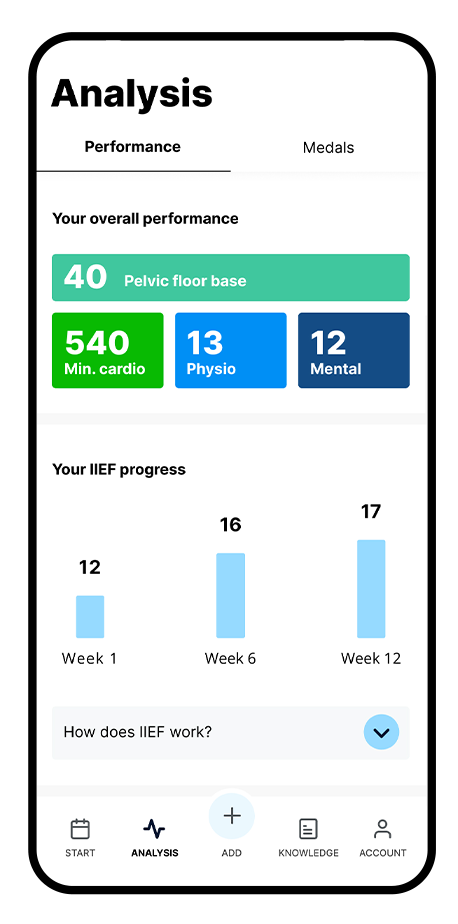Kranus Edera -
The therapy for erectile dysfunction.
Developed by doctors and is 100% reimbursed by German health insurance companies. Currently available in Germany and France.
Content of the digital program.
Kranus Edera provides a comprehensive, holistic 12-week therapy program designed to address and treat the underlying causes of erectile dysfunction effectively.
Scientifically based
No costs for patients in Germany
Combinable with medication
Safe and certified
Scientifically based
No costs for patients in Germany
Combinable with medication
Safe and certified
What our patients say about Kranus Edera.
Developed and recommended by doctors and medical experts.
Strong erection has never been so easy!
Kranus Edera offers a unique therapy that effectively and sustainably treats the underlying causes of erectile dysfunction without medication.
Look forward to your digital therapy anytime and anywhere.
Frequently Asked Questions.
-
Erectile dysfunction, or ED for short, is a dysfunctional or absent erection of the penis during sexual arousal. According to the medical definition, erectile dysfunction exists if the symptoms persist for at least 6 months and prevent satisfactory sexual intercourse in over 70% of cases. A simple questionnaire is used to determine how severe the erection problems are. This value is also used as a comparative value to measure the improvement in erection after successful treatment. This value is called the IIEF score. The International Index of Erectile Function (IIEF) is an internationally validated questionnaire that is used to assess the severity of erectile dysfunction and to evaluate the success of treatment.
Based on the results of the questionnaire, the patient is categorised into one of the following categories. The result is the sum of the individual question scores:
22-25 points: no erectile dysfunction
17-21 points: mild erectile dysfunction
12-16 points: mild to moderate erectile dysfunction
8-11 points: moderate to severe erectile dysfunction
less than 8 points: severe erectile dysfunction
-
During sexual stimulation, the brain sends signals to the penis via the spinal cord and nerves. This leads to the expansion of arteries and blood flow into the corpora cavernosa of the penis. Due to the increased pressure, the penis becomes hard. At the same time, blood outflow is slowed down by compressing the veins in the penis. As long as the inflow of blood is greater than the outflow, the erection is maintained.
Every part of this system, including thoughts, nerves, and blood vessels, must function to enable a satisfactory erection. There are various reasons why this system may be disturbed, leading to erectile problems. Often, it is not just one reason that leads to erectile dysfunction, but many reasons that come together.
Possible causes of erectile dysfunction include:
Psychological causes, such as stress, insecurity, and fear of failure;
Arterial or venous problems that lead to suboptimal blood flow to and from the penis;
Hormonal disorders, such as a lack of testosterone;
Anatomical causes that can be triggered by a pre-existing condition, e.g., phimosis or scarred changes on the penis;
Side effects caused by taking medications and other substances (e.g., antidepressants, blood pressure drugs, painkillers, or anabolic steroids);
Nerve damage caused by surgical procedures, accidents, or other diseases;
In old age or with risk factors, the elasticity of the connective tissue decreases. This leads to arteriosclerotic changes, i.e., calcifications of the vessels. Risk factors for this include high blood pressure, obesity, smoking, or an unhealthy lifestyle with little exercise and poor diet.
The decrease in elasticity and the calcifications mean that the arteries can no longer expand as well and blood flow to the penis is restricted. By the way, this also happens in the larger vessels in the body, e.g., the coronary arteries. Since the vessels in the penis are significantly smaller and are the first to be affected by the calcifications, erectile dysfunction can be seen as a warning sign for a heart attack or stroke.
-
Yes, you can continue to take PDE-5 inhibitors. However, it may be that taking PDE-5 inhibitors is no longer necessary or the dose can be reduced.
-
The pelvic floor closes off the abdominal cavity at the bottom and consists of various muscles and connective tissue. The muscles run in different layers, one above the other in a fan shape between the anterior pubic bone, the posterior coccyx and the lateral ischial bones.
The pelvic floor has the shape of a flat funnel that is open at the top. There are openings for the urethra and the anus, as well as for nerves and blood vessels. Without a pelvic floor, gravity would cause the internal organs (i.e. prostate, bladder, bowel) to slide downwards and lie under the skin on the perineum. The pelvic floor muscles stretch like a net between the bones. The front part surrounds the penis like a sling.
This part of the pelvic floor muscles is important for sexuality. By specifically tensing the pelvic floor muscles, the blood can be held in the penis during an erection - similar to using a penis ring. Well-trained pelvic floor muscles can therefore lead to a longer erection and have a positive effect on premature ejaculation.
-
Digital health applications, or DiGA for short, are apps whose costs are covered by the statutory health insurance funds. According to the Digital Health Applications Ordinance (DiGAV), a DiGA must be a certified medical device in risk classes I and IIa and be able to demonstrate positive health care effects. The effect of the apps must be scientifically proven by high-quality studies and is reviewed by the Federal Institute for Drugs and Medical Devices (BfArM).
-
Kranus Edera was developed by leading experts from the following fields: Physiotherapy, sports medicine, psycho- and sex therapy, fitness training and urology. From a medical perspective, the programme was developed by Prof. Dr. Kurt Miller and Dr. Laura Wiemer, both from the Department of Urology at Charité, and is continuously supervised by them. The effectiveness of the programme has been scientifically proven in the EDDIG study. This is a randomised controlled study with 241 study participants. The study demonstrated an improvement in erectile function as well as an increase in quality of life and an improved understanding of the disease as a result of treatment with Edera. Based on the study results, Edera was finally approved as a DiGA by the BfArM in March 2023. This is comparable to the authorisation of a new drug.
-
No, nobody has to do all the content. Generally speaking, nothing is compulsory. For some men, the focus is on mental problems, for whom the mental and sexual therapy exercises are more important. For men with cardiovascular problems, interval training is more important. For men who cannot maintain an erection for long, pelvic floor training may help the most.
BUT: All the contents have a positive effect on erections and it does no one any harm to do them all! You get the best results if you do everything.
-
As Edera is a holistic therapy without the use of medication, it takes between 2-4 weeks for most patients to notice initial successes. It is therefore worth persevering a little and being patient. The results are all the more long-lasting for it.
-
Each Edera therapy cycle lasts 12 weeks. As the long-term implementation and, above all, maintenance of your new habits often takes longer, it may make sense to carry out several cycles of Edera therapy.
However, this is very individual. In general, it can be said that doing the exercises regularly helps to maintain an improved erection in the long term.
Do you already know our therapy for voding dysfunction?
Treat bladder voiding dysfunction with a digital solution!
The goal is to reduce the urge to urinate, the frequency of urination, and incontinence episodes through a holistic and symptom-oriented digital therapy.





















